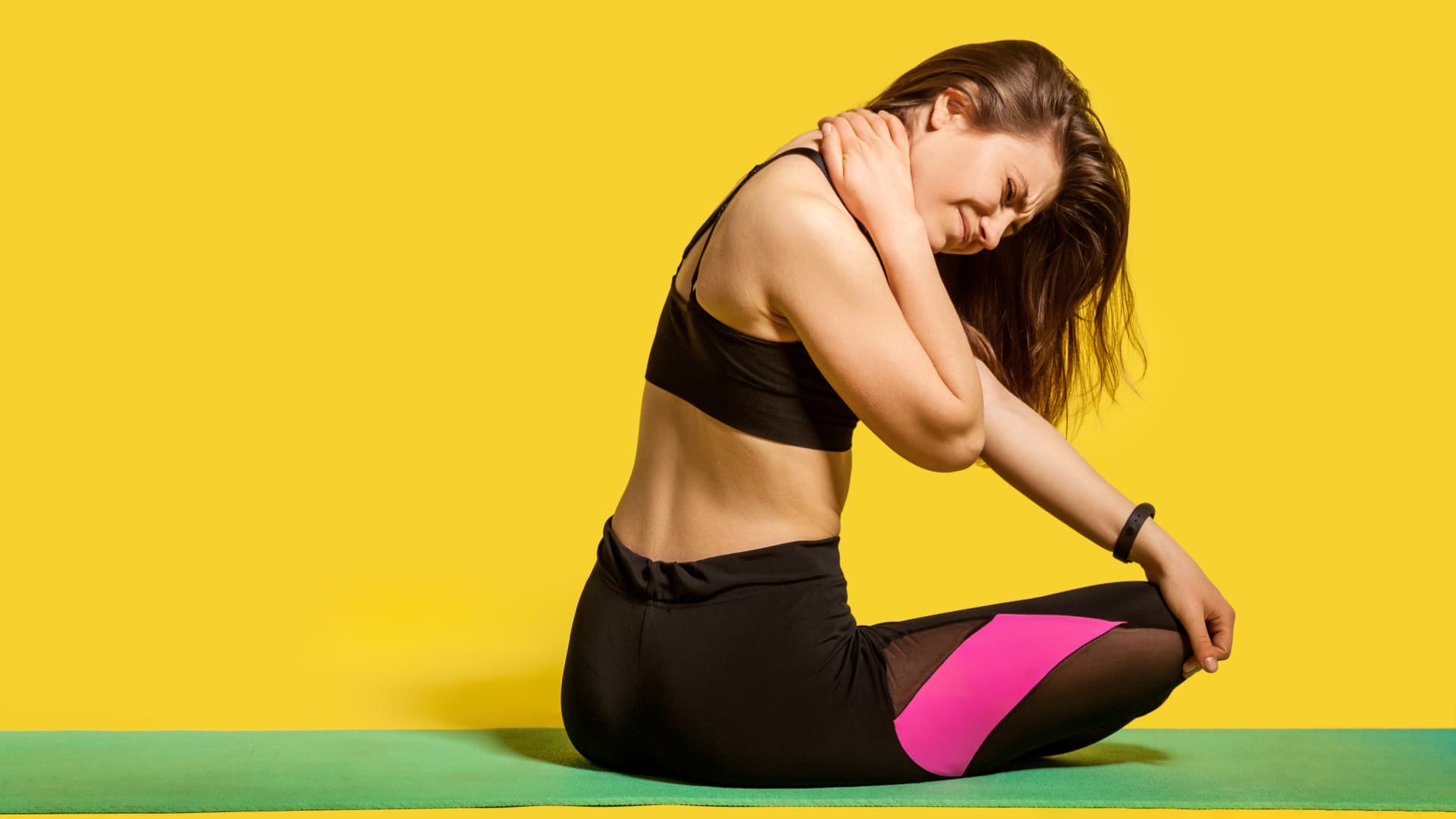
Whether it’s working at a computer desk or scrolling on the phone, we spend a lot of time looking down — usually slouching at the same time.
As we slouch, our shoulders round and our head moves forward, leading to a painful condition known as “text neck.”
This causes the upper back to become weak and the chest to become tight. Over time, the shoulders may overcompensate, leading to painful knots in the neck and shoulders, and even headaches.
How to help prevent neck and shoulder pain
As a fitness trainer, I do five stretch exercises every morning to prevent neck and shoulder pain, especially ones caused by text neck:
1. Myofascial release of the chest
I like starting with myofascial release exercises — massages that target pain in the fascial tissue that wrap around your muscles — because they help to loosen you up.
Steps:
- Take a lacrosse ball (or a myofascial release ball, the size of a tangerine) and press firmly as you roll it up and down the area where your shoulder and chest connect.
- If you want a deeper massage, place the ball between your chest and the corner of a wall. Find a knot (a tender spot), and move your body up and down to rub the ball across the knot.
- Do this for 30 to 60 seconds, then repeat on the other side.
2. Myofascial release of the upper traps
Next, loosen and warm up the muscles in the back by focusing on your trapezius muscles (a.k.a. our “traps”), which are in your upper back between your shoulders and neck. These traps get very tense when you round your shoulders forward.
Steps:
- Take the myofascial release ball in your right hand and place it on top of your left shoulder near the neck.
- Move the ball around until you find a knot. Then press the ball onto your shoulder and let your arm hang. The weight of your arm will help the ball work into any knots you may have.
- Do this for 30 to 60 seconds, then repeat on the other side.
3. Wall angels
Now it’s time to strengthen the upper back. When we round our shoulders, our upper back stretches out, so we don’t use those muscles very much. This weakens them, causing us to overcompensate with our traps.
Steps:
- Sit against the wall and press your low back into the wall. This does not need to be a deep “wall sit,” but a comfortable seat.
- Lift your arms into the shape of a “W” doing your best to keep your elbows and wrists against the wall.
- Move your arms up the wall about a foot, all while keeping your low back against the wall and your wrists and elbows as close as possible to the wall.
- Return to your starting position.
- Do three sets of 10 reps.
4. Chest stretch
This deeper stretch helps lengthen the muscles and increase range of motion.
Steps:
- Face a wall and lift your right arm out to the side. Place your palm and your entire arm against the wall.
- Slowly begin rotating your body to the left away from the wall. Stop when the intensity of the stretch reaches a six out of 10.
- Hold for 30 seconds to two minutes, then repeat on the other side. While you’re holding, try different positions with your hand, primarily moving your arm slightly higher for a deeper stretch.
5. Neck circles
There are more than 20 muscles in your neck, and these circles give you a chance to see which, if any, are tight.
Steps:
- Clasp your hands behind your back to “pull” your shoulders back.
- Start with your chin to your chest and slowly roll your head so your right ear goes toward your right shoulder.
- Slowly look up at the ceiling, continue the circle so your left ear goes towards your left shoulder, then return your chin to your chest.
- Reverse the direction.
- If any position in this circle feels extra tense, pause and allow the stretch to occur for about 30 seconds before continuing.
- Do three to four circles in each direction.
Keep in mind that these exercises are not for everyone. If you have a physical condition or health concerns, consult with your doctor before trying any of the stretches.
And while this routine can prevent or relieve pain, I also recommend creating an environment where you don’t need to look down as often.
This means holding your phone up when looking at it, making sure you have an ergonomic desk setup, and getting movement in throughout the day.
Stephanie Mellinger is a certified personal trainer and corrective exercise specialist. She is also the founder of Omnia Fit and a writer for HealthDay. Follow her on Instagram @omnia_fit_.
Don’t miss:

